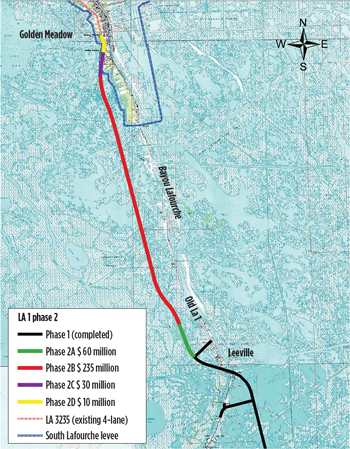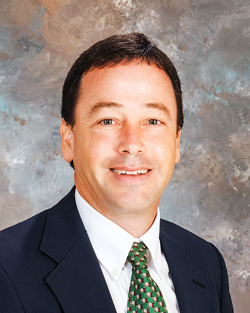 |
| Updated status of the Louisiana Highway 1 Improvement project. |
|
The concerted 17-year effort to acquire financing, and complete the elevated replacement of the critical, but often-impassable, Louisiana Highway 1 corridor in Lafourche Parish, has set its sights on offshore production funds.
Louisiana’s share of royalty revenue from the 2006 Gulf of Mexico federal lease sales has emerged as a more promising option for the segmented construction of a state-of-the-art highway, to replace the rapidly sinking LA-1 that provides the only access to Port Fourchon, and is virtually defenseless against storms. Last year, federal penalties, lumped into the so-called BP Restore Act arising from the 2009 oil spill litigation, were seen as the most viable route to the $345 million needed to wrap up the second phase of the Louisiana Highway 1 Improvement Project. Henri Boulet, executive director of the 58-member LA-1 Coalition, said judicial realities, however, make OCS revenue sharing a more likely financing source for the project, which is designed to ensure continual access to the strategic deepwater port and a significant chunk of the nation’s energy supply.
“OCS royalty sharing has moved to number one, and Restore Act funds number two,” Boulet said. “As we get closer to OCS revenue sharing from the 2006 lease sales, and revenues hitting Louisiana coffers, perhaps by 2017, that is a more probable scenario at this point. We have to realize that RESTORE ACT funds (civil penalties assessed from the oil spill) could be tied up for years through the judicial process, so there’s no way of knowing exactly what will happen with that.”
On the flip side, Boulet said the OCS revenue comes with a legislative catch: The share that each Gulf Coast state receives is capped, and only a small percentage can be earmarked for infrastructure enhancements. “Current federal regulation puts a cap on the amount that any Gulf state can receive at $500 million a year, and of that, there’s a limit of 15% that can be used for infrastructure. Furthermore, the latest estimates show Louisiana only receiving $140 million per year, although this is likely to grow with the immense deepwater activity forecasted off Louisiana’s coast,” Boulet said. “The governor (Bobby Jindal–Rep.) has set up a commission to look at bonding out those revenues, but currently, there simply isn’t enough reliable data on these projected revenues to bring to the bond market.”
“STEADILY ADVANCING”
Meanwhile, as of mid-March, the preliminary design of the final 8.3-mi stretch in Phase II, between Golden Meadow and Leeville, was 95% complete, Boulet said. Once completed, the engineering consultantancy will begin the final design for the $46-million segment at Golden Meadow that will include a 140-ft-long span over the levee, to provide utility access for construction equipment and crews to complete the remaining segments to the south. This section is being financed with $40 million in state funding, with the industry contributing the remaining $6 million.
 |
| “We’re steadily advancing. Our design is moving along”—Henri Boulet, executive director, LA-1 Coalition. |
|
Boulet said engineering consultantancy HNTB is expected to have the final design completed by next summer, clearing the way for construction. The engineering firm, the Louisiana Department of Transportation and Development (DOTD), and the U.S. Corps of Engineers, jointly concluded that the 140-ft span over the federally controlled South Lafourche Levee System provides the most cost-effective, environmentally sound structure for crossing the levee. “The levee crossing sits within the 3,400-ft Segment C of Phase II, which is the highest priority, since it will provide the necessary utility to complete Segment B further south,” Boulet said.
“We’re steadily advancing. Our design is moving along, and the funding is a little bit more secured, relative to the $46-million segment we’re now working on,” he said.
In other LA-1-related developments over the past year, the U.S. Department of Transportation (DOT), in December, approved refinancing of the $176-million LA-1 debt, meaning that the original toll schedule on the Leeville Bridge will be maintained. Boulet said the debt restructuring will save toll payers upwards of $34 million over the pay-off period. “Our goal for the debt restructuring was to lower our interest payments, so that toll revenues meet anticipated debt payments,” he said. “The original toll rate schedule can now remain in place. Without this refinancing, the Louisiana Transportation Authority could have been forced to raise toll
rates 108%.”
In addition, this past January, the Louisiana DOTD kicked off a year-long, $200,000, full-corridor safety study of Highway 3235, a four-lane roadway that extends from Larose to Golden Meadow, where it intersects LA-1. Owing to escalating traffic into Port Fourchon, the LA-1 Coalition, which added 12 new members last year, is encouraged that the state has initiated the study, citing increased highway fatalities. “The study is designed to make travel to Fourchon much safer,” Boulet said. “With all the heavy trucks now traveling into Fourchon, we’ve seen a lot of fatalities, mainly at the intersections.”
The latest traffic numbers from the State DOTD bear that out, showing a daily average of 3,741 vehicles traveling to either Port Fourchon or the nearby recreational fishing hub of Grand Isle. The vehicles-per-day tally jumps to 4,400 during the summer, Boulet said, adding that 65% of the traffic is headed to Port Fourchon, with the daily vehicle count including up to 600 large freight trucks.
Boulet said the coalition efforts last year got the attention of the U.S. Government Accounting Office (GAO), which as part of a nationwide climate change study last summer, recognized the completed 11-mi. stretch of elevated LA-1 between Leeville and Port Fourchon as a “shining example of resilient infrastructure projects, designed to withstand future sea level rise.” Boulet said GAO representatives had a post-Hurricane Isaac field visit to the project and came away impressed, which was documented in GAO’s report to Congress. “Louisiana State Highway 1 demonstrates, in near-real time, the benefits of specific adaptations in design,” the GAO wrote in part. “Having the old road adjacent to the new one, and documenting impacts to both, is a good start in moving towards understanding the benefits of investments in adaptation, as opposed to investing in disaster recovery.”
The report noted that the elevated segment of LA-1 was largely unaffected by the hurricane, despite the approximately 6.5-ft storm surge measured at Port Fourchon. 
|




